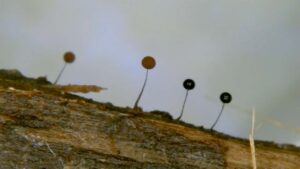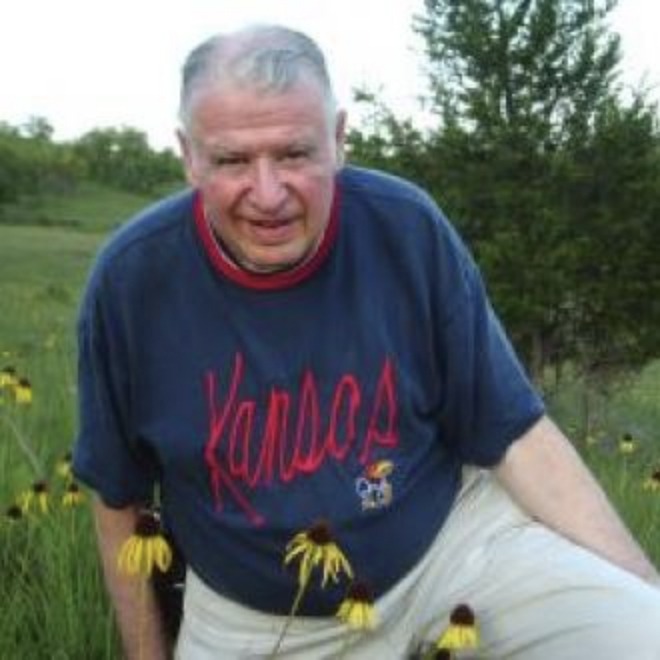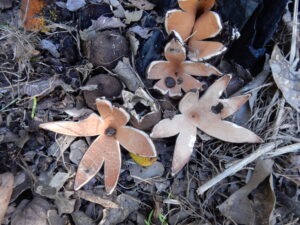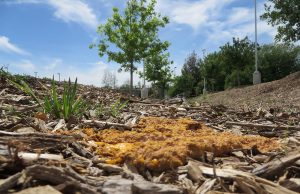Harold is a native Kansan, who grew up on the edge of the Flint Hills at Peabody. He graduated from Peabody High School and subsequently earned his Bachelor of Arts degree in biology from Kansas Wesleyan University in 1960. The summer of 1957 was spent in the Lolo National Forest, Powell Ranger District, Idaho, as a lookout observer located at Diablo Mountain Lookout overlooking the Selway-Bitterroot Primitive area. In 1958 he was a smokechaser, trail crew worker and telephone lineman climbing trees, repairing and re-hanging telephone line in the Elk Summit Guard Station area of Powell Ranger District. These experiences were highlighted with scenic photographs of Powell Ranger District, Idaho published in the Lookout Network magazine and is now posted on their national website as a featured article. These life experiences in the U.S. Forest Service led to his interest in plants and a professional career as a teacher, researcher, and university professor in botany and mycology.
He received his Master of Arts in Botany in 1963 from The University of Kansas under Professor Dr. Ronald L. McGregor, who directed his thesis entitled “A comparative anatomical study of the genus Echinacea” later published in JBRIT. He became interested in the Myxomycetes in the early 1960s while at The University of Kansas and has actively pursued their collection and study ever since.
He earned the rank of Captain in the United States Army Medical Service Corps during the Viet Nam Era from 1964 to 1967 stationed at Third U.S. Army Headquarters in Atlanta, Georgia as Chief of Parasitology, Mycology, and Medical Illustration. In 1967 he began his doctoral thesis on Myxomycetes with Professor Dr. George W. Martin, who directed his dissertation entitled “The Genus Perichaena (Myxomycetes): A Taxonomic and Cultural Study”. and received his Doctor of Philosophy degree from The University of Iowa in 1971.
He was selected as a one-year postdoctoral fellow in a nationwide competition by The University of Florida Graduate School to study the Myxomycetes of Florida. In 1971 he was selected as one of 25 recent Ph.D.’s nationwide to participate as a National Science Foundation Fellow in the “Summer Institute in Systematics V, Origin and Measurement of Diversity” held at the Smithsonian Institute.
He has served as a faculty member teaching courses at five different universities that included Principles of Biology: Organismic and Ecology, General Microbiology and Human Infectious Diseases for nurses, Biology of Lower Plants, Plant Biology, Biology of Economic Plants, Medical Parasitology and Medical Mycology, Biological Literature, History of Biology, and Biology of Slime Molds among others.
He joined BRIT as a Research Associate in the early 1990s and has published more than 66 book reviews for the JBRIT Press, participated in the Book Review Club (four as lead reviewer), published 130 articles that include peer reviewed journal papers, newsletters, book chapters. and published abstracts (146) of oral and poster presentations. Represented in these publications is one book entitled “Myxomycetes of Ohio: Their Systematics, Biology and Use in Teaching” published in 1999.
He has given presentations at professional meetings such as The International Mycological Congress, International Congress on the Systematics and Ecology of Myxomycetes. (ICSEM 2, 3, 4, 5, 6, 7, 8) and he delivered the invited Plenary Address at ICSEM2 held at Madrid, Spain and the Keynote Address for ICSEM8 held at Changchun, China 2015 (read in absentia) at the Mycological Society of America (MSA), and Association of Southeastern Biologists (ASB), and North American Mycological Association (NAMA) annual meetings. Numerous myxomycete workshops titled “The Wonderful World of Myxomycetes” and “Myxomycete Systematics Workshop” were presented at ICSEM, MSA, and NAMA meetings.
His research on the biology, ecology, systematics, and tree canopy biodiversity of myxomycetes and fungi and mentoring undergraduate and Master Degree graduate students that was supported financially by grants from the National Science Foundation (8), National Institutes of Health (4), National Geographic Society (1), Discover Life in America (2), U.S. Department of Education (1) and the Missouri Department of Natural Resources (2) among other institutional grants.
His students at University of Central Missouri used the Double Rope Climbing Method to access, survey, and inventory the tree canopy for cryptogams in the Great Smoky Mountains National Park and the Daniel Boone National Forest in Kentucky and this activity was highlighted in a recent issue of the Journal of the Botanical Research Institute of Texas (JBRIT). He currently serves on the Editorial Board for The BRIT Press, has served on search committees for BRIT staff, and is a Contributing Editor for the new journal FUNGI.
Apparently, this paper published in FUNGI in 2010 titled “Importance of Myxomycetes in biological research and teaching”.is the most cited publication on Myxomycetes based on monthly reports from the Digital Commons at the University of Nebraska at Lincoln. This paper has had 5.599 downloads as of May, 2023 after first being posted on June, 2016. There is world map that shows the downloads for each country on their dashboard.
Team research projects have resulted in recent publications with BRIT staff, BRIT Research Associates, and mentoring of a recent high school graduate and undergraduate university student intern Vanessa Marshal. She co-authored the publication of a new myxomycete species. Licea iridescens, in JBRIT. Keller, H.W. and V.M. Marshall. 2019. A new iridescent corticolous myxomycete species (Licea: Liceaceae: Liceales) and crystals on American elm tree bark in Texas, U.S.A. Journal of the Botanical Research Institute of Texas 13(2): 367–386. Vanessa is in her final stages of completing her doctorate degree at the University of Alabama.
Select Publications:
Keller, H.W. 2023. Diablo Mountain Lookout, Past and Present: Powell Ranger District, Idaho. Lookout Network Vol. 34, No. 1-2: 26-28.
Keller, H.W. and Bob O’Kennon. 2023. Re-discovery of Lysurus mokusin, lantern stinkhorn mass fruiting bodies on soil at Fort Worth Botanic Garden, Texas Fungi 16 (1): 64
Keller HW, SE Everhart, CM Kilgore. 2021. Myxomycetes: Basic Biology, Life Cycles, Genetics and Reproduction. Pp. 1–45 in: Myxomycetes: Biology, Systematics, Biogeography and Ecology, 2nd Edition, edited by C Rojas, S Stephenson. Elsevier An Imprint of Academic Press, Atlanta, GA.
Keller HW. 2021. Morel mushrooms, macrofungi, corticolous myxomycetes, and American elm trees. FUNGI 14:23-34.
Keller HW. 2020. The Cross Shot: Grave Peak Lookout, Powell Ranger District, Idaho. Lookout Network 30(3-4):23.
Keller HW, RL Price, BG Stone, ED Forrester. 2020. Arcyria versicolor of western mountains, U.S.A. (Myxomycetes: Trichiales: Trichiaceae): A morphological and taxonomic study with observations of nivicolous species. Journal of the Botanical Research Institute of Texas 14(2):435-459. doi.org/10.17348/jbrit.v14.i2.1021
Lopes-Andrade C, ML Ferro, HW Keller. 2020. A new species of Cis Latrielle (Coleoptera: Ciidae) from the USA, with comments on the use by Ciidae of Stereaceae Fungi (Basidiomycota: Agaricomycetes: Russulales) as hosts. The Coleopterists Bulletin 74(1):93–100. doi.org/10.1649/0010-065X-74.1.93
O’Kennon, B, HW Keller, BA Bunyard. 2020. Observation of the stinkhorn Lysurus mokusin (Phallales: Phallaceae), and other fungi found on the BRIT campus in Texas. FUNGI 13(3):41–48.
Perry BA, HW Keller, ED Forrester, BG Stone. 2020. A new corticolous species of Mycena sect. Viscipelles (Basidiomycota: Agaricales) from the bark of a living American Elm tree in Texas, U.S.A. Journal of the Botanical Research Institute of Texas 14(2):167-185. doi.org/10.17348/jbrit.v14.i2.1000
Keller HW. 2019. Student team-based tree canopy biodiversity in Great Smoky Mountains National Park. Plant Sci. Bull. 65(1): 28–37.
Keller HW, VM Marshall. 2019. A new corticolous myxomycete species (Licea: Liceaceae: Liceales) and crystals on American elm tree bark in Texas, U.S.A. J. Bot. Res. Inst. Texas 13(2):367‒386.
Keller HW, KL Snell. 2018. Hunting and collecting Myxomycetes at night with a flashlight. FUNGI 11(2):43–44. www.fungimag.com/summer-2018-articles/Flashlight%20LR.pdf
O’Kennon B, D Benjamin, HW Keller. 2018. Xylobolus frustulatus (Stereaceae): Developmental observations, morphology, and ecology. FUNGI 10(4):16–21. https://bit.ly/2JiUdR0
O’Kennon, B, HW Keller, BA Bunyard. 2020. Observation of the stinkhorn Lysurus mokusin (Phallales: Phallaceae), and other fungi found on the BRIT campus in Texas. FUNGI 13(3):41–48.
Keller, HW, KM Barfield. 2017. The Great Smoky Mountains National Park: The People’s Park. FUNGI. 10(2): 44–64.
Keller HW, SE Everhart, CM Kilgore. 2017. The Myxomycetes: Basic biology, life cycles, genetics and reproduction. Chapter 1, pp. 1–40, in Myxomycetes: Biology, systematics, biogeography and ecology. Edited by S Stephenson, C Rojas. Elsevier, Atlanta, GA.
Keller HW, B O’Kennon, G Gunn. 2016. World record myxomycete Fuligo septica fruiting body (aethalium). FUNGI 9(2):6–11.
Keller, HW. 2015. More than 50 years with Myxomycetes (plasmodial slime molds): Highlights and review. Taxonomy and Ecology of Myxomycetes. Higher Education Progress. 9-28, Beijing, China. Keynote address at the Eigth International Congress on Systematics and Ecology of Myxomycetes held in Changchun, China (People’s Government of Jilin Province).
Keller, HW. 2014. The genus Echinacea (Asteraceae): Floral, stem, and petiole morphology. Journal of the Botanical Research Institute of Texas. 8:87–126.





